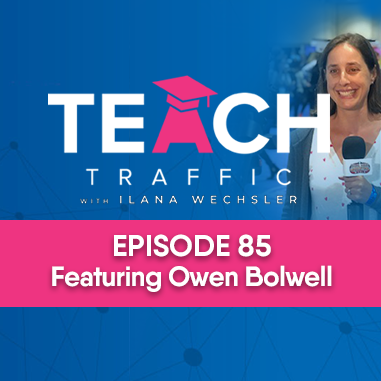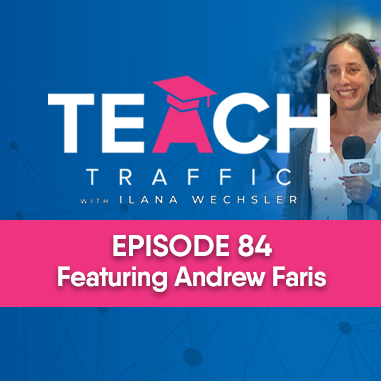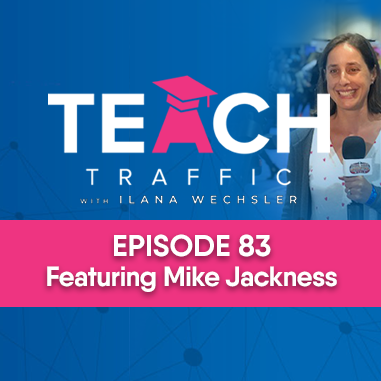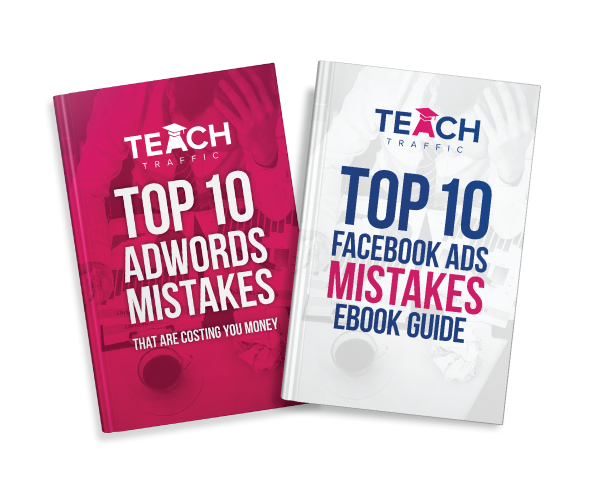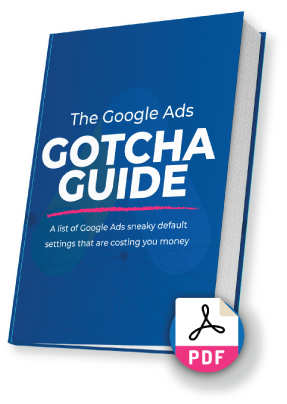How To Boost Your Business Using Challenge Marketing with Angela Henderson
In the podcast:
01:03 – Podcast Updates
00:41 – Episode Overview
04:33 – Guest Introduction
07:14 – What is Challenge Marketing
11:13 – Free and Paid Challenge
15:37 – Initial Steps into Starting a Challenge Marketing
21:07 – How Do You Market a Challenge
24:24 – What Would Angela Do Differently
26:40 – Thoughts on Timed Challenges
Running a ‘challenge’ is a great way to boost your email list. Angela Henderson and I discuss the various types of ‘challenges’ you can run in your business, regardless of the industry you are in. We discuss if you should make your ‘challenge’ free or paid, how long they should run for and the one key element to your challenge which will make it a successful one. Don’t miss this episode.
How To Generate Leads & Sales From LinkedIn (Without Having To Pay For Ads) With Paul Higgins in PDF
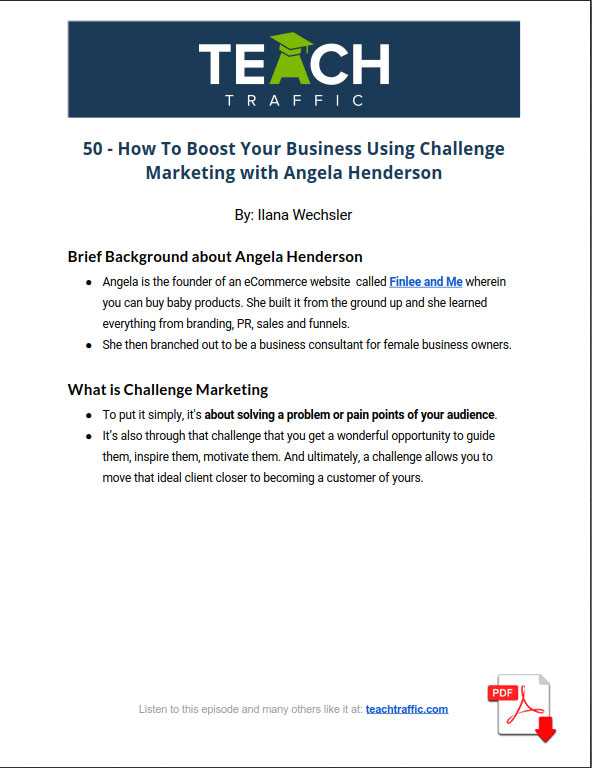
Episode Overview
Ilana:
Welcome back to another episode of Teach Traffic. I am your host, Ilana Wechsler. And if you’ve been listening to this podcast for a little while, you might notice that it has a new name.
Yes, this podcast didn’t used to be called Talking Web Marketing but I have changed the name to be Teach Traffic. And that’s because we are building out a really awesome website called TeachTraffic.com , which will have all the podcast episodes, show notes, handful PDF guides, as well as our training, membership everything in one place.
So today’s episode will be live on TeachTraffic.com , and I’ve got a really interesting episode today. Today I’m talking to a girl that I’ve known for a little while. Her name is Angela Henderson.
And Angela is a really interesting person. And we talked about some interesting things on today’s episode a bit of a background about Angela. She was the founder of an online store called Finlee and Me, it was like an eCommerce store which she built from the ground up and she learned everything from branding and PR and sales funnels and all that kind of stuff. And then is now branched out to be a business consultant and helps I think so.
Specifically women business owners or female business owners. And on today’s episode, we talk all about Challenge Marketing. And I’m a big fan of running a challenge. If you don’t know what a challenge is, well then you’ve got lots of interesting information to listen to on today’s episode.
I ran a challenge a few months ago, called my seven day retargeting challenge, where in seven days I teach people how to build a retargeting campaign on both Facebook and on Google considering it still astounds me that so many people only run their retargeting campaigns on one ad platform.
So I ran a retargeting seven day challenge which was really really successful. You can check it out. The old link is https://greenarrowdigital.com/retargeting-challenge/. I will also make that available on TeachTraffic.com.
But on this episode, Angela and I talk all about Challenge marketing. Why you should run a challenge in your business? What’s the best way to structure them? Should they be a one off event?
Or should you make them evergreen? all the questions that you possibly have when it comes to running a challenge and incorporating a challenge into your business as a form of lead generation. We talk all about it in today’s episode, so let’s get stuck right in.
Ilana:
Alrighty. So welcome to today’s episode of Teach Traffic. Today I have a wonderful guest called Angela Henderson. Thank you for coming on today’s episode.
Angela Henderson:
Thanks for having me today!
Ilana:
It’s an absolute pleasure to have you on. And before we hit record, and you and I have been sort of talking a little bit and a lot, actually, actually. And I’ve definitely realized that we could have gone lots of different ways with today’s episode.
But we have settled on a topic, which I really do love talking about, because it’s something I’ve done personally, and I know you have done a lot.
And so what we’re going to be talking about is how to increase sales and get more clients through Challenge Marketing. So you are definitely somebody who knows a lot about this more than me.
So I’m excited to talk to you about that today. So thanks for coming on. Before we do get stuck into the content of today’s episode and the nitty gritty of the types of challenges that you can run and why you’d want to do one and how to do a challenge. Do you want to give our listeners a quick sort of five seconds about who you are and what you do?
Guest Introduction
Angela Henderson:
Yes, sure, I would love to do that. So my name is obviously as Ilana said, Angela Henderson. I am currently a business consultant specifically working with women in business to help move them really from that overwhelm and stuckness.
And so often visit women in business working in their business, to helping shift them to working in gaining that clarity and strategy they need to grow that 4,5,6 figure and beyond businesses.
And so I do that via one to one consulting, I do that via my group coaching program. I do that through my you know, Women in Business Retreat, my podcast, etc.
But that’s really only been the last two and a bit years that I’ve been doing the consulting gig before that I opened up an eCommerce business almost 10 years ago called Finlee and Me. And that business was ultimately around creating childhood memories through play, love and travel.
We had at one stage 1400 different products, we are selling again from an eCommerce platform. And I also was looking at other ways to monetize that business.
And so I did that by opening up my own blog, I became one of Australia’s leading parenting bloggers working with companies like Netflix, piano cruises, and a variety of other you know, international and national brands.
And it was through that platform that people started wanting to pick, you know, pick my brain. And I started taking on you know, coffee dates with people. And from there Angela Henderson consulting, you know, kind of sprouted and as where we’re at today,
Ilana:
Interesting, I’m always fascinated in people’s journeys, and not my journey has definitely also taken lots of twists and turns along the way. So I can relate to starting one thing, and then ending up in a completely different place.
But I’m sure like me, you never would have dreamed you’d end up where you are. Now, had you not started back where you had originally started with your eCommerce store? It’s funny, because some people that, you know, end up at an eCommerce store or when that’s where you started. It’s funny isnt?
Angela Henderson:
100% I think it’s also about people giving themselves permission to pivot if necessary, I think, you know, I always had this thing that, oh, I will have this baby business forever.
Oh, I will sell it. And then, you know, as my kids got older, and it was harder to kind of find toys, and I really wanted to keep, you know, those are online store between newborn and say, six, seven years of age.
And as my kids started to hit that 6,7,8, you know, eight year olds, landmark, it was kind of like, Oh, you know, I don’t have a kind of losing my passion. I’m kind of losing my joy doesn’t bring me as much happiness as it did. And then Luckily, like I said, I think the universe kind of works its own magic.
Sometimes people like I said, start asked to pick my brain and, you know, and then I pivoted, so it was one of those things that again, something I never thought I would do, and then I pivoted and and that’s okay, so, you know, always remember that it’s okay to give yourself permission to pivot if necessary.
What is Challenge Marketing
Ilana:
Definitely. Okay. I want to digress from today’s topic. So let’s talk about Challenge Marketing. So for those of our listeners who don’t know what challenge marketing is, do you want to kind of give us a brief overview and an intro of what exactly it is?
Angela Henderson:
Sure. Challenge marketing, you know, often I get asked, you know, what is a challenge? Why would it work for my business? Why would it and and so… I guess I’m just looking at challenge marketing is really it’s about helping solve a problem for your audience.
And that challenge can run for three day challenge, a five day challenge, a seven day challenge, 10 day, 14, 30 Day Challenge doesn’t matter.
But ultimately, it’s through that challenge that you’re ultimately going to be able to solve one of your ideal clients pain points. It’s also through that challenge that you get a wonderful opportunity to guide them, inspire them, motivate them. And also ultimately, a challenge allows you to move that ideal client closer to becoming a customer of yours.
So yeah, so that’s ultimately, you know, what a challenge it was all about and how it works.
Ilana:
Interesting. So I personally have done the challenge and some of our listeners might have done my challenge. I did a seven day retargeting challenge, actually.
So I do know quite a bit about this topic. And it’s sort of like dawned on me one day where I was thinking like, you know about who my ideal customer is.
And as I go all if I can teach them how to do a retargeting campaign, then they’re going to experience the wonders of pay per click advertising, and therefore want to do more of it.
And so that’s the sort of the entry point for somebody is often you know, to do a retargeting campaign for the, in my line of work. So I think the topic and the topic selection is key in order to a successful challenge. Would you agree with that?
Angela Henderson:
Yes. 100%. Again, I think if you don’t have a clear topic that has a clear attached outcome to that, I think most businesses will struggle to have a successful challenge.
So you know, for example, some of my pain points from my clients, was my first business was about even though I was is an eCommerce platform, it was important to realize that those people who are buying for me were also moms.
And moms are not all moms. But a lot of moms are juggling many hats and very busy. And there’s at times, it can feel a disconnect from their children.
And so I did a 30 days, 30 ways on how to connect with your child, which was just literally every day they received an email, I did a quick video into my Facebook community. This is like, here’s a five minute thing that you can do with your kids.
And the amount of transformation that came from those moms and how grateful they were and you know, thankful they were for that was amazing.
But for those that might be in the business, you know, realm, such as the one that you did with your seven day challenge is you can do you know, my one was a five day challenge and how to discover how to increase sales and get more clients through challenge marketing. So I actually taught people how to set up their entire challenge.
Another friend of mine, Zach, sparkler does the free day live training, so build? You know, again, he too is all about challenge marketing. So he builds a five day challenge to flip into a five figure launch. A friend of mine, Stevie Dylan, she had one called the complete roadmap to social media success.
Another friend of mine from years ago, Jada seldom there did one around the three day green smoothie challenge. So there’s a variety of different ones that you can do. But again, making sure that you hit a pain point that your ideal client has, and helped them transform it during that period of a challenge.
Free and Paid Challenge
Ilana:
Yeah, and I think that’s key what you just said, help them transform. I think the best success with challenges is if you deliver some kind of in result, or as you say, transform. Another type of challenge that I’ve done for a client of mine was a 21 day plant based eating challenge.
So there are a million in one ways to slice and dice these challenges. One question I did have, is this whole concept of Do you do a free or a paid challenge? What are your thoughts on that?
Angela Henderson:
Again, I think first of all, it depends on where your ideal client is sitting within your funnel. So for example, if they are a cold client, they know nothing about you or your services. And, you know, I personally would probably be going down the track of making it unpaid.
Because, you know, the reason why, again, I guess, when we go back a little bit a lot about why I believe a challenge works is that you get opportunity to really bring new people into your business who may not know about you, they may know about you, but a lot of times it’s that cold traffic.
It allows you to really build on that H to H, human to human marketing and that relationship building, it helps to build trust, credibility, and authority ultimately helps to build your email list.
And it also increases your visibility, reach and sales. But to go back to that question that you have there is is it should be paid or unpaid? Again, a cold audience, they know nothing about you.
So to me, would you rather do that do an unpaid challenge and get them in so they can start building that trust with you that credibility with you get to know you hear you see you all of that, and potentially warm them enough to convert them at the end of that challenge? Or is your main objective?
Do you mean to make money? I don’t know. So I guess there’s a few questions that you have to ask is What is your angle by having it free, and what is your angle by having it paid, because if they don’t know you, and they’re not warm, or even hot, and they bought from you before, I would say that it would probably be a much harder slog to try to get them paying for a challenge.
Ilana:
It’s interesting, I was once talking to a client of mine was sort of they had done a lot of challenges. And they had done challenges in the sort of the health space, it’s like, I think it was a 30 days, sort of six abs, some kind of challenge, something like that.
And they had, they ran a massive challenge they used to get like 15,000 people sign up to there are many, there’s a six week challenge. I don’t remember the specifics, but something along those lines, and they ran a free challenge.
And it was hugely popular. As I said, 15,000 people on their email list, develop the relationship, and they were selling supplements of sort of the back end of that challenge will throughout the challenge, right.
And they obviously not everyone would sign up for their supplements, but some people did, etc. And it was reasonably successful. And then they thought, let’s just try and do a paid challenge.
And let’s see, as the end result by the different type of customers we have, so they charge a pretty low price for it, I think it was under $100. For, for their challenge, obviously got significantly less people into their challenge.
Maybe a third of that 5000 people, but the quality of those people that they did get was significantly higher. And those were actually much better, potentially customers for their supplements.
So it’s interesting, I guess it’s the trade off between quality versus quantity and different metrics, you know.
Angela Henderson:
And also, I think it’s also about your offer, right. So like, if you’ve got a higher offer that’s like, you know, a group coaching program, or one to one coaching, or, you know, I don’t know, Facebook ads, you know, year long course, or something like that, where you’re talking like $1,000 ,2,000, 3000, whatever, you’re going to need a longer runway, right.
And so again, it’s that free challenge gives you that ability to create that runway, then getting to know you like and trust you so that eventually when you do offer that higher ticket item, they’ve had a longer runway to get to know you. Whereas if you’ve got a smaller item that meant let’s just say the supplements were 50,60 $70, the risk is lower, but the gain is higher.
So I think again, you’ve got to look at what is the end result? What are you offering? At the end? If you’re offering any? Is it a low ticket item? Or a high ticket item?
Do you want to pre qualify the leads and make them better quality? Or are you just your main goal is is like I said to get as many people in to help with like your brand awareness, your voice profiling like all of that. So I think you really have to go back to what is it that you want to accomplish by running a paid or unpaid challenge?
Initial Steps into Starting a Challenge Marketing
Ilana:
Yeah, exactly. Okay. So for our listeners who are thinking, and this could be really good for my business. What are some of the initial steps that if like, you just decide, yes, I want to run some kind of challenge. So you mentioned that you had a Free Facebook group. Was the sequence of events that someone registers for the free challenge, I’m assuming, and then they put into your free Facebook group is that kind of how it works?
Angela Henderson:
Right, so we did both organic traffic, like organic marketing, and then we did paid marketing. And either way, they would go to a registration page. And then they would go into a thank you page. And on that thank you page, we would be prompting them to join the Facebook community. So that right off the bat, they’re starting to get more touch points with me, they’re starting to build there’s relationships with the other members within the community.
And then yeah, so that was the initial phases. And then with the actual running of the five day challenge is we send one daily email out, which also has the link to download the workbook.
And the next thing we do is that will I do a live video inside of that Facebook group so that they can hear me teach whatever I’m teaching for that particular day, walk them through the workbook? And answer any questions that they have.
So that’s kind of what that looks like. And then after the particular challenge is then I open up cart for whatever I’m offering. So in that instance, I was offering my year long group coaching program, which is called Profit Pillars with Angela Henderson. And then yeah, and then they go into, you know, the funnel, post that with cart open for seven days, and then closing on that be the end of the seventh day.
Ilana:
Okay, so did your challenge, have a set start date that everyone was starting at the same time?
Angela Henderson:
That’s correct. Yep. So we had a set start date, I didn’t allow other people to join in on when the challenge challenge was live, I know, some people will do that. But for me, I was creating more like, again, then that scarcity factor that this is it, you need to join by this day, it’s a private Facebook community, this is what we’re doing.
Whereas I have heard other people, they will run their challenge on their Facebook page versus having a Facebook group.
But for me, it’s again, I like to keep things intimate, because again, I’m really big about that human to human marketing, that connectedness with people, and so I would much rather have an intimate and quality group than trying to do it, you know, vast and big.
Again, there’s pros and cons to each of those, if you run it off your Facebook page, then you can add some Facebook ads to that later on. Whereas if you’re only running it in your Facebook group, you you can’t run ads to that group, you know, then it’s not really a scarcity model.
And then some people get shitty going, Well, if you were just going to run it off your page, why did I sign up to your emails, I could have just gotten it for free anyways. So again, these are all the things that you have to kind of ask yourself when you’re setting that challenge up.
Ilana:
Interesting. And I’m assuming during the duration of the the challenge, people are asking questions and stuff, is the idea then that at the end of the challenge, you shut the group down? I mean, what happens to all that content that’s in there?
Angela Henderson:
Yep. So then I close that group whenever I run my challenges, and I feed them into my primary Facebook community of almost 6000 members, which is called the Australian Business collaborative.
So they can still do me mingle with me, they can still get great quality content, but then they can still be around community and promote their business and all of that. But again, in regards to that specifics around the challenge that closes down until I open up another challenge.
Ilana:
okay. And then you reopen that same group, or you open up a completely brand new group?
Angela Henderson:
Nope. So I in the past have just kept reopening that same group. And the reason why is, is those members are still in there, if they haven’t left the group, and they’re like, oh, my goodness, this is a really great reminder, I’m so glad that I can just join in again, or this is really great, because I can learn something new and tweak my challenge that I’ve already done.
Right? So I just keep those going. And then I just keep building on that community. And then again, close it down and filter them in the Australian Business collaborative.
Ilana:
Interesting. It’s funny, a personal preference of mine, or lack of preference, a hate of mine, I really detest Facebook groups, I just find them, I just find it really difficult to find threads and blah, blah, blah.
And so when I did my challenge, I bucked the trend, because I know that a lot of people open Facebook groups, and I just created a special part in my membership for the challenge.
And, yeah, I think it did work well. But I’m sure a Facebook group is so seamless and easy for people because they’re probably on Facebook already. And it comes up in their newsfeed, etc. And it’s free to create one. So I can definitely see the benefits of that.
Angela Henderson:
Yeah 100%. And that’s the thing is, is for my ideal client, they’re sitting on Facebook. So for me is it’s like Facebook, I mean, their phone is in their hand, they’re opening up Facebook a million times a day, right? So again, even if they’d may not go into the group, for example.
And even though they may have signed up for it, the reality of it is is my branding is still showing up in their feed every single day multiple touch points, right?
So it’s I guess it’s that strategic element is even with the Australian Business Collaborative group, you know, there’s not a lot of people who are act, there’s a lot of people who are in the background, taking in all information, there’s equally just as a very active group.
But again, every time something happens by me that’s going into their newsfeed. So I’m I’m still directly Jimmy marketing myself, every single time.
How Do You Market a Challenge
Ilana:
Yeah. Okay, so we’ve talked about some, a lot of the, the nuts and bolts of the challenge, and hopefully our listeners can see some applications of how they can apply it to their business. One question that I’m sure there’s some people might be thinking is will how did you market such a challenge? Like, how did you? Yeah, how did you market it had to get the word out there?
Angela Henderson:
Yep. So there is a body of work, obviously, the unpaid ways was marketing it to my email list, marketing it in my facebook group, marketing it in a variety of other
Facebook groups, having other people who I’m friends with who have similar ideal clients, but we’re not competitors, they would put share it in their newsletters. And then obviously, just constantly still sharing it on LinkedIn, Instagram, Facebook, etc.
So those are all the organic ways that we marketed, we also did test Facebook ads for those, which again, worked relatively well. Again, as many of you know, sometimes you just got to find the right algorithm and the way they show things and etc. So yes, we also use Facebook paid ads for this particular campaign.
Ilana:
And I guess that’s a logical place to to really advertise, especially when you’re ultimately getting people into a Facebook group. They’re not, they’re not on Facebook anyway, they’re not going to see your ad and then they’re going to be in the group. So
Angela Henderson:
Yes, exactly. Right.
Ilana:
Cool. Alrighty. So, obviously, it was successful for you. And so you were teaching people how they too, can use challenges, is that right?
Angela Henderson:
That’s correct it because one of the big problems that a lot of the clients that I work with have is increasing their sales and getting more clients.
And so again, a challenge helps to solve those problems. Because ultimately, you’re not only building your email list, you’re building your credibility so that you can sell to them post the event.
But obviously a challenge, you know, I always say, when you’re looking at setting up your challenge, you want to know, what are you offering at the end of that challenge, which that comes in how you’re going to increase your sales.
So that’s again, the beauty about a challenge is it actually helps you to increase your sales and get more clients in multiple ways, both immediately after the challenge, or long term when they’re on your email list.
On that particular one. If I go through like a my 30 days, 30 ways challenge, my whole purpose of that challenge, running it with my business family and me was to build my email list.
And then on the back end of that, you know, start to sell them my particular products that we had within the store. And so we had on that particular occasion, 1752 people sign up, a friend of mine again, Stevie Dylan, her offer on the back end of hers was for her course, she had 2500 people sign up, she had 160 people purchase, which equaled $95,000.
So her conversion rate on that one was 6.4%. On my discover how to increase sales and get more clients. into my group coaching program, I had only 100 I say only but this is where it’s important. I had 225 people sign up, which is relatively low. However, 10 people purchase from that making my sales total for that particular challenge at 22,000. My conversion rate was 4%.
My friends among Carla who are from the merrymakers, they had the back end was an offer for their course, they had 510 people sign up 192 people purchased, and they made $18,000, which was a 37% converted, they had a lower ticket item.
So you can see that it, there’s a variety of ways that you can make sales off the back end. And that’s the whole point how to increase your sales and get more clients is challenged. Marketing allows you to do that.
What Would Angela Do Differently
Ilana:
Yeah, amazing results. What would you say? Like, if you were to do it again, what were some of your learnings that you would apply if you were doing it again?
Angela Henderson:
Yep. So if I were to do it again, and I will be running another one here shortly is I won’t make it a five day I’ll make it a three day challenge. Because again, it with my ideal client cohort, being women in business, who are also ultimately moms, they’re balancing a lot.
And I think five days for them as in the lawful an awful lot to kind of block out and put their heads face to. I also have found that even with running the 30 days, 30 way challenge and how to connect with your child with my first business, Finlee
and me is that 30 days is a long time for anyone to commit to.
So one of the things that again, I would say to you is that when you’re looking at a three, day five, day seven day, 10 day, etc, the longer your challenge is you just need to know that you’re going to have an equally proportionate people kind of filter off, right? Because it just becomes life gets in the way.
That’s all it is. It doesn’t mean that they don’t like you or they don’t like what you’re doing it just life gets in the way. So what I would do for the next time is I would definitely shorten my challenge to a three day challenge.
Ilana:
Interesting. And then I guess it’s about then selecting something actionable that they can achieve in three days.
Angela Henderson:
Exactly right. So I still believe that I can still run the exact same challenge on how to increase sales and get more clients. But I will chunk together two of the learning topics every day versus doing one learning topic a day.
Because they’re really not that hard to do. Right? It’s so that’s how I will spin it on that one. But again, if you’re doing something complex, like how to do a retargeting campaign, or whatever, you might have to do mean, because it’s quite techie, it might be new to them, you know, their brain has to work extra hard that maybe you do need the five days.
So again, it just goes back to what are you teaching? And what is your ideal client? How long are they going to stick around for?
Ilana:
Okay? So that’s one thing that you would change it you make it shorter? Is there anything else that you would change?
Angela Henderson:
Um, listen, I think on our last round, our copy that we had, for our ads could have been a bit tighter, I don’t necessarily know that gentlemen, hit the hit the ideal client and their pain points away that I probably would have liked to have. So again, for this next round is again, I’m going to just test some new copy and see again, what works best.
Thoughts on Timed Challenges
Ilana:
What about making it evergreen, like not having a start and an end date? What are your thoughts on that?
Angela Henderson:
Yep. So I actually have an evergreen webinar. And I think it’s a great way as part of a funnel, you know, setting it up can be a bit tedious to say the least.
Ilana:
What I mean is an evergreen challenge.
Angela Henderson:
Yeah, I mean, it would be the same thing, whether or not you evergreen, a webinar evergreen a challenge. Absolutely. My only downfall. And this is what I would also say is, even with a webinar webinars a one off doing, I think it’s very hard to convert someone off of our cold traffic off of a one instance, when I’m running a challenge, again, you could ever great, but remember, you’re not getting that level of human connection, because you’re not going to obviously have a Facebook group that you’re sending them to, because you’re not going to be in that every day.
You’re just letting them kind of do the course content. So I think the disadvantage of evergreen a challenge is that there’s that lack of human connectedness, and some people need that in order to sustain and or build upon that credibility, authority and trust.
Ilana:
Interesting.
Angela Henderson:
But, I would say test. You know, like, just because I’m saying that doesn’t mean that that’s what is the end all and be all Test, test and test some more. But it comes down to a numbers game, anything we do is numbers. So you know, Denise Duffield Thomas, in her latest book, “Chillpreneur“, you know, she’s a good friend of mine. And we talked, you know, at lunch one day about its numbers, she converts at 1%.
So she needs 100 people to get on her challenge or 100 people to get on the webinar or 100 people to go through her funnel in order to make one sale. So if you have 1000 people, you’re going to get 10 sales. So you know, again, you need to really know your numbers for your industry and understand how many people do you need to get through whether or not it’s evergreen? Or whether or not it’s a webinar? What however, you really need to go what are your numbers? And what does that conversion look like for you?
Ilana:
Yeah, I personally am a really big fan of challenges. And I think that they, as you’ve said, you know, they’re a great way for people to know, like, and trust you and get to know you, in a really like micro commitment kind of way, like you’re not asking them to, you know, like three days like I can, I can get some help for three days. And that’s not asking me to marry someone.
Angela Henderson:
Totally. And I also think, you know, with challenges, if I go back to that human to human kind of marketing perspective, is that conversation equals conversion. And so whenever you have an opportunity to have really rich and juicy conversations via email, and then in a Facebook group, and then teach them via video, is you’re creating conversations.
And it’s through those conversations that people start to get to know you like you trust you, and the conversions will happen. And another quote that I really like is that I’ve learned that people will forget what you said, people will forget what you did, but people will never forget how you made them feel.
So when you’re in a Facebook group, and you’re delivering a challenge, and you’re saying like, hey, Ilana, how are you today? How are the kids? What have you been up to? You know, and you take time to really get to know that there’s people not just about your challenge, but just in general. They any make them in have those fields, you know, those they might not buy from me right away, but they’re going to stick around and get to know you longer.
Ilana:
That’s awesome. Well, I think we’ve pretty much covered everything that I wanted to talk about, is there something that you think that I have not asked you?
Angela Henderson:
No, I think that pretty much covers it. And, you know, for those that are looking at, you know, challenge marketing, or if you’re looking at ways to you know, get from stuck to unstuck and to get some clarity and strategy, you know, feel free to connect with me over on my Facebook community, the Australian Business Collaborative, don’t freak out, because it’s not just Australians that are in there. It’s just the name of the group. Or again, you can head to my podcast, which is Business and Life Conversations with Angela Henderson. And yeah, we’d love to connect.
Ilana:
That’s awesome. Well, that saves me asking the question of how we could find more about you (laughs). And for those of your listeners who want to do my seven day retargeting challenge, you can go to what is the URL https://greenarrowdigital.com/retargeting-challenge/.
And yes, it is it is an evergreen challenge is not yet live one. We did run it live at one point. So um, Angela, thank you so much for coming on today’s episode. It’s been a blast and a long time coming. So I’m glad to finally connected with you. And yeah, thank you so much for your time.
Angela Henderson:
No worries. Thanks for having me.
